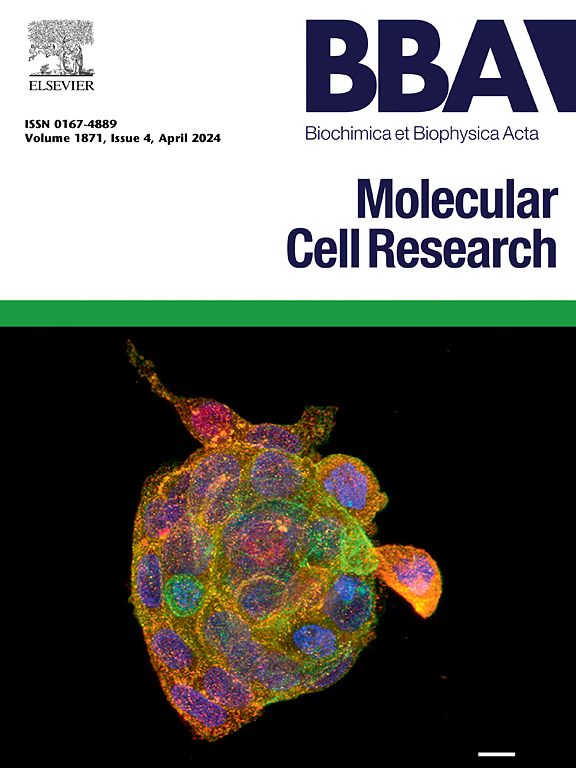肉毒毒素A通过抑制PARP14/ socs2介导的巨噬细胞M2极化来预防增生性瘢痕形成。
IF 3.7
2区 生物学
Q1 BIOCHEMISTRY & MOLECULAR BIOLOGY
Biochimica et biophysica acta. Molecular cell research
Pub Date : 2025-06-10
DOI:10.1016/j.bbamcr.2025.120003
引用次数: 0
摘要
肉毒毒素A (BTXA)是一种安全且广泛应用于美容程序和医疗应用的神经毒性蛋白。本研究主要探讨肉毒毒素a在增生性瘢痕形成过程中对巨噬细胞表型的影响及其作用机制。建立了HS小鼠模型,其中肉毒毒素治疗以剂量依赖的方式减少了真皮厚度,表皮增生和胶原沉积。此外,肉毒毒素减少了瘢痕组织内的纤维化、增殖、血管生成和M2巨噬细胞标志物,在诱导的M2巨噬细胞(来自THP-1单核细胞)和人真皮成纤维细胞(HDFs)的体外共培养系统中也获得了类似的结果。根据生物信息学和RNA测序的见解,我们发现在小鼠伤口皮肤中,BTXA处理抑制了聚(adp -核糖)聚合酶家族成员14 (PARP14)和细胞因子信号传导抑制因子2 (SOCS2)的表达增加。PARP14增强了SOCS2 mRNA的稳定性。PARP14的过表达恢复了巨噬细胞的M2极化,并否定了肉毒毒素对hs的改善作用。然而,这些效应被小鼠或THP-1细胞中SOCS2的额外沉默所抵消。综上所述,本研究提示肉毒毒素抑制parp14介导的SOCS2 RNA稳定,减少巨噬细胞M2极化,减轻肥厚性瘢痕形成。本文章由计算机程序翻译,如有差异,请以英文原文为准。
Botulinum toxin A prevents hypertrophic scarring by suppressing PARP14/SOCS2-mediated M2 polarization of macrophages
Botulinum toxin A (BTXA) is a safe and widely used neurotoxic protein in cosmetic procedures and medical applications. This investigation focuses on the function of BTXA on macrophage phenotype during hypertrophic scar (HS) formation and the underlying functional mechanism. A mouse model of HS was generated, where BTXA treatment reduced dermal thickness, epidermal hyperplasia, and collagen deposition in a dose-dependent manner. Moreover, BTXA reduced fibrosis, proliferation, angiogenesis, and M2 macrophage markers within the scar tissues, with parallel findings obtained in the in vitro co-culture system of induced M2 macrophages (derived from THP-1 monocytes) and human dermal fibroblasts (HDFs). Following bioinformatics and RNA sequencing insights, we identified increased expression of poly (ADP-ribose) polymerase family member 14 (PARP14) and suppressor of cytokine signaling 2 (SOCS2) in wound skin of mice, which were suppressed by BTXA treatment. PARP14 enhanced SOCS2 mRNA stability. Overexpression of PARP14 restored the M2 polarization of macrophages and negated the HS-ameliorating effects of BTXA. However, these effects were counteracted by the additional silencing of SOCS2 in mice or THP-1 cells. In conclusion, this investigation suggests that BTXA inhibits PARP14-mediated SOCS2 RNA stabilization to reduce M2 polarization of macrophages and alleviate hypertrophic scarring.
求助全文
通过发布文献求助,成功后即可免费获取论文全文。
去求助
来源期刊
CiteScore
10.00
自引率
2.00%
发文量
151
审稿时长
44 days
期刊介绍:
BBA Molecular Cell Research focuses on understanding the mechanisms of cellular processes at the molecular level. These include aspects of cellular signaling, signal transduction, cell cycle, apoptosis, intracellular trafficking, secretory and endocytic pathways, biogenesis of cell organelles, cytoskeletal structures, cellular interactions, cell/tissue differentiation and cellular enzymology. Also included are studies at the interface between Cell Biology and Biophysics which apply for example novel imaging methods for characterizing cellular processes.

 求助内容:
求助内容: 应助结果提醒方式:
应助结果提醒方式:


